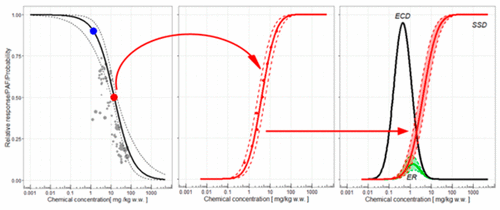当前位置:
X-MOL 学术
›
Environ. Sci. Technol.
›
论文详情
Our official English website, www.x-mol.net, welcomes your
feedback! (Note: you will need to create a separate account there.)
Deriving Field-Based Ecological Risks for Bird Species.
Environmental Science & Technology ( IF 10.8 ) Pub Date : 2018-03-09 , DOI: 10.1021/acs.est.7b05904 Renske P J Hoondert 1 , Jelle P Hilbers 1 , A Jan Hendriks 1 , Mark A J Huijbregts 1
Environmental Science & Technology ( IF 10.8 ) Pub Date : 2018-03-09 , DOI: 10.1021/acs.est.7b05904 Renske P J Hoondert 1 , Jelle P Hilbers 1 , A Jan Hendriks 1 , Mark A J Huijbregts 1
Affiliation

|
Ecological risks (ERs) of pollutants are typically assessed using species sensitivity distributions (SSDs), based on effect concentrations obtained from bioassays with unknown representativeness for field conditions. Alternatively, monitoring data relating breeding success in bird populations to egg concentrations may be used. In this study, we developed a procedure to derive SSDs for birds based on field data of egg concentrations and reproductive success. As an example, we derived field-based SSDs for p, p'-DDE and polychlorinated biphenyls (PCBs) exposure to birds. These SSDs were used to calculate ERs for these two chemicals in the American Great Lakes and the Arctic. First, we obtained field data of p, p'-DDE and PCBs egg concentrations and reproductive success from the literature. Second, these field data were used to fit exposure-response curves along the upper boundary (right margin) of the response's distribution (95th quantile), also called quantile regression analysis. The upper boundary is used to account for heterogeneity in reproductive success induced by other external factors. Third, the species-specific EC10/50s obtained from the field-based exposure-response curves were used to derive SSDs per chemical. Finally, the SSDs were combined with specific exposure data for both compounds in the two areas to calculate the ER. We found that the ERs of combined exposure to these two chemicals were a factor of 5-35 higher in the Great Lakes compared to Arctic regions. Uncertainty in the species-specific exposure-response curves and related SSDs was mainly caused by the limited number of field exposure-response data for bird species. With sufficient monitoring data, our method can be used to quantify field-based ecological risks for other chemicals, species groups, and regions of interest.
中文翻译:

得出鸟类的野外生态风险。
污染物的生态风险(ER)通常根据物种敏感性分布(SSD)进行评估,该灵敏度基于从对田间条件具有未知代表性的生物测定中获得的影响浓度来确定。可替代地,可以使用将鸟类种群的育种成功与蛋浓度相关的监测数据。在这项研究中,我们开发了一种基于鸡蛋浓度和繁殖成功率的野外数据得出鸟类SSD的程序。例如,我们推导出了基于现场的固态硬盘,用于对鸟暴露的p,p'-DDE和多氯联苯(PCB)。这些SSD用于计算美国大湖区和北极地区这两种化学物质的ER。首先,我们从文献中获得了p,p'-DDE和PCBs鸡蛋浓度和繁殖成功率的现场数据。第二,这些场数据用于拟合响应分布(第95个分位数)的上边界(右边界)的曝光-响应曲线,也称为分位数回归分析。上限用于解释由其他外部因素引起的生殖成功中的异质性。第三,从现场暴露-响应曲线获得的特定物种EC10 / 50s用于推导每种化学品的SSD。最后,将SSD与这两个区域中两种化合物的具体暴露数据结合起来以计算ER。我们发现,与北极地区相比,五大湖地区这两种化学物质共同暴露的ERs高出5-35倍。特定物种的暴露-响应曲线和相关SSD的不确定性主要是由于鸟类的现场暴露-响应数据数量有限所致。有了足够的监测数据,我们的方法可以用于量化其他化学品,物种组和目标地区的基于现场的生态风险。
更新日期:2018-03-10
中文翻译:

得出鸟类的野外生态风险。
污染物的生态风险(ER)通常根据物种敏感性分布(SSD)进行评估,该灵敏度基于从对田间条件具有未知代表性的生物测定中获得的影响浓度来确定。可替代地,可以使用将鸟类种群的育种成功与蛋浓度相关的监测数据。在这项研究中,我们开发了一种基于鸡蛋浓度和繁殖成功率的野外数据得出鸟类SSD的程序。例如,我们推导出了基于现场的固态硬盘,用于对鸟暴露的p,p'-DDE和多氯联苯(PCB)。这些SSD用于计算美国大湖区和北极地区这两种化学物质的ER。首先,我们从文献中获得了p,p'-DDE和PCBs鸡蛋浓度和繁殖成功率的现场数据。第二,这些场数据用于拟合响应分布(第95个分位数)的上边界(右边界)的曝光-响应曲线,也称为分位数回归分析。上限用于解释由其他外部因素引起的生殖成功中的异质性。第三,从现场暴露-响应曲线获得的特定物种EC10 / 50s用于推导每种化学品的SSD。最后,将SSD与这两个区域中两种化合物的具体暴露数据结合起来以计算ER。我们发现,与北极地区相比,五大湖地区这两种化学物质共同暴露的ERs高出5-35倍。特定物种的暴露-响应曲线和相关SSD的不确定性主要是由于鸟类的现场暴露-响应数据数量有限所致。有了足够的监测数据,我们的方法可以用于量化其他化学品,物种组和目标地区的基于现场的生态风险。











































 京公网安备 11010802027423号
京公网安备 11010802027423号